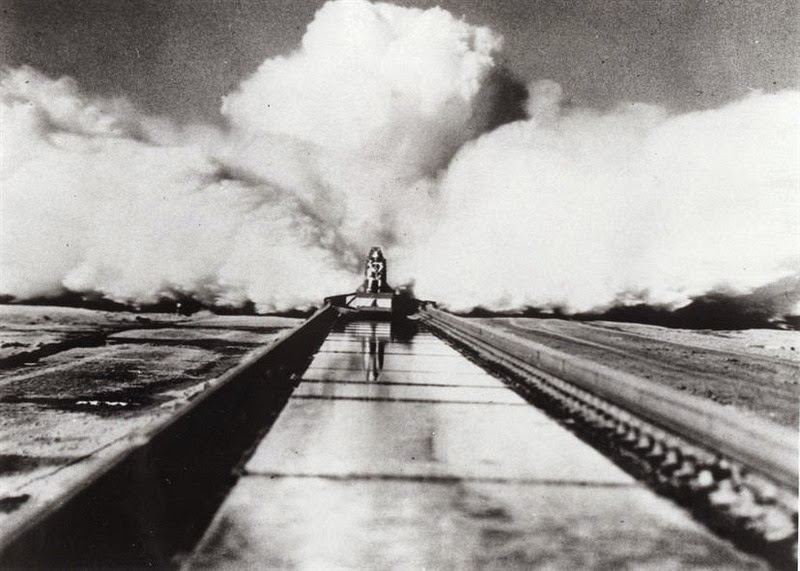If highway speed limits of 70-80 miles per hour is too slow for you, pay a visit to Holloman Air Force Base in south-central New Mexico, in the U.S. Operated by United States Department of Defense, Holloman is home to the world's longest and fastest high speed test track at 15.47 km in length, and consequently the world’s highest enforced speed limit. A sign near the track announces, in all seriousness – “Mach 10”. Ten times the speed of sound or 7,612.07 miles per hour. That’s how fast you are officially allowed to go, and is probably the only speed limit that you can break and get applauded for instead of being issued a ticket. Nobody has broken it yet – the fastest land speed record at Holloman High Speed Test Track is Mach 8.5 set in April 2003.
Holloman Air Force Base is located in New Mexico's Tularosa Basin between the Sacramento and San Andres mountain ranges, about 16 km west of Alamogordo, on U.S. Route 70/82. The base is situated in a relatively flat high desert country at an average elevation of about 4,200 feet surrounded by approximately 300 square miles of mountainous terrain with peaks extending up to 9,000 feet. The maximum temperature can reach 110 degrees Fahrenheit in the summer and a minimum of zero degrees in the winter, but otherwise, the weather is quite pleasant. So far, very little test time has been lost to bad weather.
The High Speed Test Track at Holloman (HHSTT) is not your usual test track used for testing cars. It’s what is known as a “rocket sled” consisting of a test platform that slides along a set of rails, propelled by rockets. A rocket sled does not use wheels. Instead, it has sliding pads, called "slippers", which are curved around the head of the rails to prevent the sled from flying off the track.
The test track allows American defence and governmental agencies to perform a variety of high speed tests. In the past, tests conducted at Holloman have led to the development of pilot ejection seats, parachutes, nuclear missiles, and seat belts.
The test track was initially just over a kilometer long when it was laid down in 1949. The first test performed at the HHSTT was the launching of the Northrop N-25 Snark in 1950, but soon included human tolerance testing. The goal of the research was to find out what would happen to a pilot's body during extreme acceleration and deceleration in an actual flight.
On Dec. 10, 1954, Lt. Col. John Stapp became the "Fastest Man on Earth" when he rode a rocket-propelled sled at a speed of 632 miles per hour, in the process enduring more than 40 times the pull of the Earth's gravity and suffering various injuries, including broken ribs and a temporarily detached retina. His findings proved a pilot flying at 35,000 feet, going twice the speed of sound, could withstand the wind blast if he or she had to eject.
In October 1982, an unmanned rocket sled blasted a 25-pound payload to a target at a speed of 6,119 miles per hour creating a record that would stand for more than 20 years until another rocket sled delivered a 192-pound payload to a target at 6,453 miles per hour. The record-breaking sled run of Mach 8.5 on April 2003 was a culminating event in the Hypersonic Upgrade Program. The program upgraded the HHSTT's capabilities in many areas, including its ability to support various tests done at hypersonic speeds, and it added the ability to test payloads carrying the weight of full-scale aircraft at realistic flight velocities.
The HHSTT is currently undergoing an upgrade to support magnetically levitated sleds to eliminate vibrations that occur on steel rail track. This system performed its first test in 2012 and continues to be operational.
A view of the Holloman High Speed Test Track from south to north. Photo credit
Satellite picture of the High Speed Test Track at Holloman.
The rocket sled that achieved Mach 8.5. Photo credit

Lt. Col. John P. Stapp propelled down the Holloman High Speed Test Track aboard the Sonic Wind Rocket Sled 1 at a rate of 632 miles per hour, earning the title "The Fastest Man on Earth." Stapp’s experiment was the last human test at the HHSTT. Photo credit
A preliminary sled run conducted on 25 February 1959 to test vibration characteristics on new instrumentation mounts. The sled hit a water brake at the end of its run, shooting water straight up into the air. Photo credit
Left: An F-22 forebody on a MASE sled at Holloman Air Force Base. Right: N-25 Snark on the Holloman Track.
Sources: Wikipedia / Official Web Site of Holloman Air Force Base




















Comments
Post a Comment